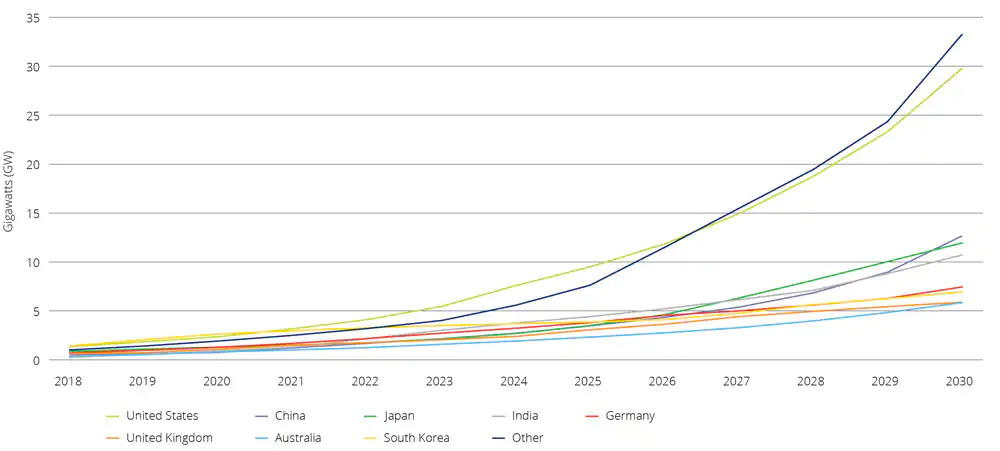In the Renewables 2019 report, the International Energy Agency predicts that renewables will account for a third of the world’s electricity by 2024. Leading in the list are onshore wind, hydropower, and offshore wind in that order.
As evident this year, renewables are still on track to become mainstream. Key to this growth has been particular technologies and interventions that are set to continue next year. From the increasingly strong contribution of artificial intelligence to investments by prominent organizations, the RE sector will have a profound 12 months.
QBI Solutions is looking at the following trends for 2023.
1. Increased Investments In Renewable Energy
Renewable energy already features as a priority business model in many organizations looking to be more sustainable. Organizations have realized that renewable energy is not only eco-friendly but also a source of positive outlook related to corporate social responsibility (CSR).
For this reason alone, we are set to see increased investments in the area. The private sector is particularly increasingly involved in the investment, having pumped in at least $10 billion in the market in one year. Expect more input from the likes of Walmart and Google.
As long as returns remain transparent, investments should proceed in 2023 and beyond. Eventually, the mega multinationals may probably turn into alternative energy producers and capture the fast-growing clean energy space.
Spain's Iberdrola is leading by example with its plan to invest at least 17 billion euros for renewables as part of 47 billion euros ($47 billion) that will go to energy-related investments from 2023.
2. Renewable Energy Storage Growth
The growing role of renewable energy in the energy grid is prompting substantial growth in energy storage. It isn’t surprising that Wood Mackenzie predicts the global deployment of this technology to reach 500 GW by 2031.
Energy storage has become prominent in recent years thanks to increased resilience and reliability. Specifically, factors such as financial incentives in some countries, grid modernization, and performance improvements for Li-ion batteries have been instrumental.
Looking at the graph below, the story of global energy storage is only starting, so we will see more of it in 2023.

Fig 1: Expected global cumulative storage deployment – 2018 to 2030 (retrieved from here)
3. More Artificial Intelligence (AI)
The International Conference on Artificial Intelligence for Renewable Energy Systems will take place between July 17 and 18, 2023 in Tokyo, Japan. Among the objectives of this conference is a discussion of the most recent trends in artificial intelligence for renewable energy technologies.
One clear thing is that AI is still underused in renewable energy. The World Economic Forum (WEF) reports that AI is mostly applied in predictive asset maintenance. More can be achieved to add to this exciting convergence. Therefore, we predict that 2023 will see more inroads in this area.
Just what more can AI do for the renewable energy market? Again, we look at the WEF report. It outlines areas such as:
- Optimized integration of variable renewable energy into the energy grid
- Support for autonomous power distribution system
- Discovery of new revenue streams
4. Enhanced Cyber Security Measures
As the renewables capacity across the globe expands, business models are evolving and regulations taking shape. Something those in the technology field will attest to is that there is an increasingly strong convergence of renewable energy and information technology/operational technology (IT/OT).
Here are some factors driving this convergence:
- Remote asset management popularity
- Pressure from regulatory elements
- More involvement of intelligent connected devices
- Asset automation and digitalization
- Reduced maintenance cost
There is no disputing that the IT/OT convergence is welcome on the economic and operational front, but the cyber-attack exposure it presents is evident. This risk can only increase as the number of renewable energy assets increases globally.
As it stands, the renewable energy infrastructure has weaknesses that intruders can exploit. Consequences from such attacks include damage to RE infrastructure, loss of revenue, theft of sensitive information, and Health, safety, and environmental (HSE) risk.
2023 will be a year where cyber security in the renewable energy sector will take center stage to alleviate the risks. Renewable energy operators are striving to identify the gaps and find remedies. Stakeholders in the industry will become more proactive in protecting critical infrastructure from attacks. We expect more research, development, and application of available solutions in access monitoring, security controls, and network segmentation, among other areas.
Conclusion
Looking at the trends for 2023, one can conclude that the energy transition wheel is turning nicely, as the crucial elements of RE growth cement themselves. The world has to answer the questions posed by the energy crisis, and renewables are slowly but surely getting the nod.
As investments in the industry increase, newer and better technologies will emerge to support the growth. Renewable energy proponents are sparing no effort ensuring that these sources power the world. This determination will make renewables attain even higher growth in 2023.

